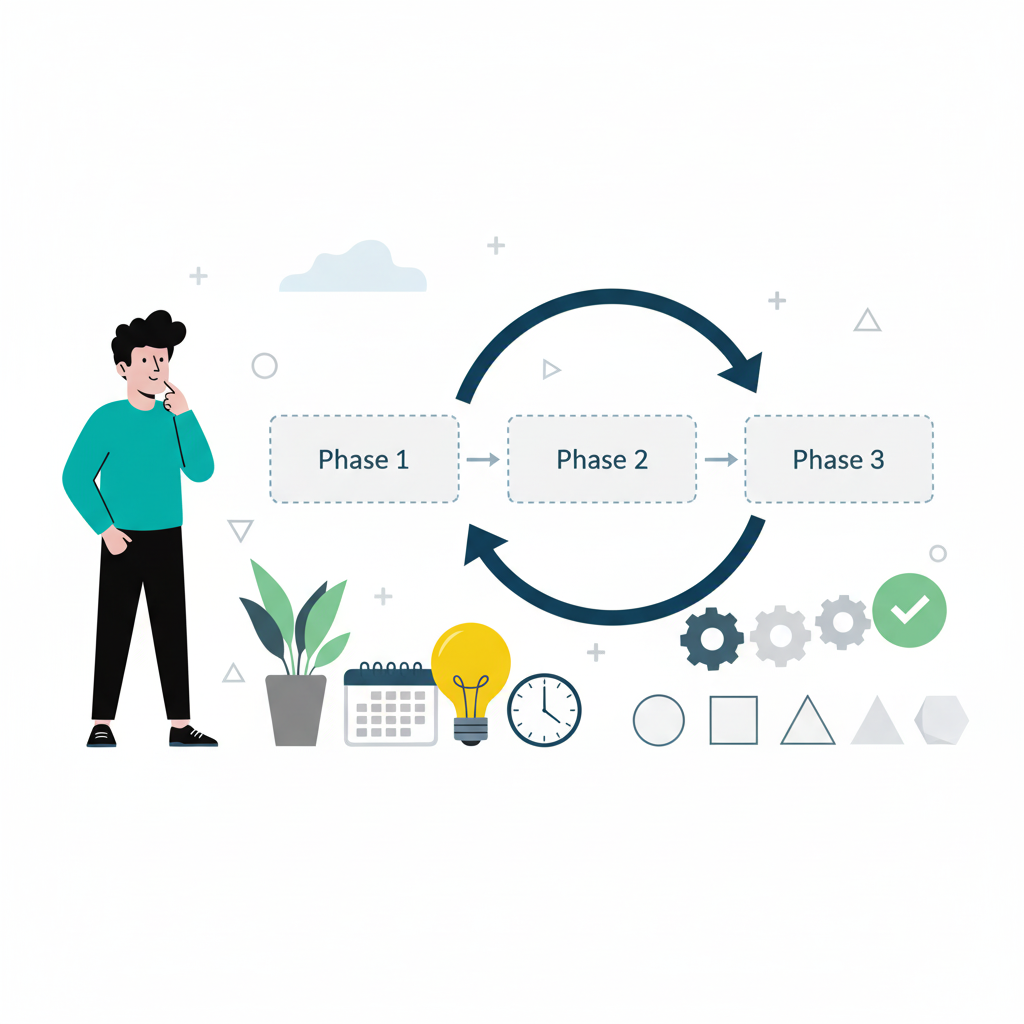You ship fast, but the code isn’t pretty. The architecture is hacky. The tests are sparse. And you feel guilty about it.
Here’s the thing though – not all code should be built to last. Sometimes the smartest engineering decision is to build something you plan to throw away. Throwaway prototypes, proof-of-concept validations, and time-boxed experiments aren’t just acceptable shortcuts – they’re recognised practices with specific scenarios where they outperform permanent solutions.
This article builds on our time horizon diagnostic framework to explore when short-term thinking becomes optimal strategy. We’re going to give you a decision framework for when planned obsolescence makes sense, the economic analysis that justifies it, and the anti-patterns that make it fail. You’ll get categories of disposable systems, ROI calculations comparing throwaway versus refactoring costs, and concrete implementation patterns that work.
What is planned obsolescence in software engineering?
Planned obsolescence is a deliberate engineering decision to build systems with a predetermined, limited lifespan. You’re accepting replacement over maintenance from day one.
It means recognising that some code should optimise for speed of learning or time-to-market rather than longevity. When frequency of reuse is low and time-to-rewrite is less than time-to-make-maintainable, throwaway code is the optimal choice.
The key distinction: this is intentional and bounded, not accidental technical debt from poor practices. Technical debt is like taking shortcuts that speed up initial development but lead to problems later. Planned obsolescence is a strategy with expiration dates and economic justification, informed by the temporal architecture framework that matches engineering decisions to realistic time horizons.
Extreme Programming gave us spike solutions as the template – time-boxed exploration with explicit deletion after learning. These aren’t failed experiments. They’re successful validation tools that served their purpose and can now be retired.
The difference between planned disposal vs forced abandonment is having a strategy versus dealing with consequences. Some teams write prototype code in a different language than production to ensure it must be rewritten before going live.
Code quality matching intended lifespan is strategic engineering.
When should you build throwaway code for proof-of-concept validation?
Use 90-day disposable systems to validate technical feasibility or test uncertain assumptions before committing to production implementation.
The economics are straightforward. A POC takes 1-2 weeks of engineering time. A production implementation takes 2-3 months. If there’s a 70% chance your hypothesis fails, the expected cost of building directly (70% × 2-3 months wasted) exceeds the POC investment (1-2 weeks validation).
POCs reduce implementation risk by validating technical feasibility and business value before full-scale development. That’s the point of them.
Set an expiration date – 90 days from start, with deletion as the expected outcome. The POC succeeds when it answers your technical question, whether the answer is “yes this works” or “no this won’t work”. Both outcomes are valuable because you get to make better decisions.
Implementation pattern: minimal coupling to production systems, separate codebase or boundaries, documented as disposable from day one. Choose high-value projects that match your team’s capabilities and start with internal, non-customer-facing projects to limit risk.
The transition decision is usually rewrite versus refactor. POC code optimised for learning rarely transitions well to production. You took shortcuts to hit speed goals – plan for a rebuild when you commit to production.
The anti-pattern here: POC that “temporarily” goes to production and becomes permanent. Set hard boundaries and deletion dates. Create forcing functions that trigger the disposal decision.
How do you determine if your MVP should be disposable?
The “viable” in MVP is about balancing minimum (speed) with viable (quality sufficient for market learning without reputation damage).
Use a six-month expiration framework. Your MVP is optimised for initial market validation, with an explicit 6-month horizon before you make the rebuild or shutdown decision.
The economic analysis: MVP development takes 4-8 weeks. A production rebuild takes 3-4 months. Refactoring debt accumulated in a permanent MVP creates ongoing drag for years. When developers allocate nearly half their time to tech debt they’re not shipping customer-facing features. So your velocity drops and keeps dropping.
Your quality threshold needs to be sufficient to validate hypotheses and capture feedback without causing “MVP hangover” – long-term brand damage from poor quality. Full rewrites take more time than rewriting separate parts, causing later delivery of features than competitors.
Disposability indicators: you’re testing completely uncertain market hypotheses, making first-time market entry, or validating business model viability where the product may pivot or shutdown.
Long-term indicators signal transition time: proven market fit, established customer base, revenue generation. These tell you to move from disposable MVP to production system.
For implementation approach: choose rapid prototyping stacks (Firebase, serverless, pre-built UI kits) for speed over maintainability. Apply strategic shortcuts for MVPs that prioritise speed while avoiding harmful debt. Use feature flags for safe experiment removal.
Launch to a private beta with limited audience and explicit “beta” framing. This manages expectations and reduces MVP hangover risk.
What changes when you’re building for a 2-year acquisition exit?
Your time horizon changes what “good” architecture means. A 2-year exit optimises differently than 10-year operation.
Technical debt that would accumulate for 10 years only exists for 2 years. This changes your cost-benefit calculation. But you can’t build a pure hack job either.
Technical due diligence scrutinises code quality, architecture decisions, and technical debt levels. The balance: fast enough to reach acquisition timeline and demonstrate traction, but clean enough to pass due diligence without killing the deal.
Your disposability strategy should focus engineering quality on systems acquirers will evaluate – core product, scalability architecture – while accepting disposable approaches for supporting systems like internal tooling and temporary marketing sites.
Buyers focus on both past and projected future performance. Maintain well-organised financials and be able to justify projections. Plans for scalability are attractive to potential buyers and you’ll need to be able to explain how you’re going to get there.
Documentation becomes more important in an acquisition context. Buyers need to understand what they’re getting. Document your architectural decisions and rationale to show intentional strategy versus careless execution.
The anti-pattern: assuming “we’ll just rewrite it if we get acquired”. Deals fall through when code quality is too poor. Acquirers discount valuation for technical debt cleanup costs and may walk away entirely.
Set your expiration date at 18-24 months from founding to acquisition target. Make architectural decisions explicitly documented as “2-year horizon choices”.
How do feature flags enable safe disposable code?
Beyond time-bounded scenarios like POCs and MVPs, another pattern enables safe disposability in ongoing operations: feature flags.
Feature flags decouple code deployment from feature exposure. You can deploy experimental code to production without risk because it’s hidden behind a flag until you’re ready.
This enables deletion-optimised patterns where removal is a first-class design goal. Build features behind flags with explicit removal plans, making disposable code safe and manageable. Feature flagging systems allow deploying new features for testing in production without exposing them to all users.
The experiment-driven approach: run progressive experiments where each iteration builds on learnings from previous disposable implementations. If a feature causes issues you can easily disable it, preventing widespread disruptions without a redeploy.
Clean removal process: flag-protected code can be safely removed without impacting production when your experiment concludes or hypothesis is invalidated. Removal-first architecture enables this disposability from the start.
The economic benefit is faster learning velocity through rapid experiments versus slower but permanent implementations.
Implementation pattern: use flag naming conventions indicating disposable versus permanent features. Document expiration dates for experimental flags. Canary deployments follow progressive rollout: 1% → 10% → 50% → 100%.
The anti-pattern: accumulating thousands of stale feature flags that never get removed. Flag debt is technical debt. You need tooling to manage this or it gets out of control.
Feature flag platforms like LaunchDarkly and Split provide infrastructure for managing experiment lifecycle and tracking flag age.
What is the economic framework for choosing throwaway versus maintainable code?
The scenarios above illustrate when to use disposable code. But how do you make the economic case to stakeholders? Here’s the framework.
Three factors drive your decision: frequency of reuse, time to rewrite versus time to make maintainable, and ability to find and reuse code later.
The ROI calculation model compares throwaway cost (initial development + rewrite cost) versus maintainable cost (longer initial development + ongoing maintenance). A 2018 Stripe study found developers spend approximately 13.5 hours weekly on tech debt and another 4 hours on poor code quality. That’s a lot of time not spent on product development.
Time horizon matters. Shorter expected lifespan favours throwaway approach. Longer horizon favours maintainability investment.
Reuse frequency has major impact. High-reuse code – shared libraries, core services – warrants quality investment. Single-use code does not.
Higher uncertainty about requirements or viability reduces the value of quality investment. Validate first, optimise later.
Opportunity cost matters. Time spent making disposable code maintainable is time not spent validating hypotheses or capturing market opportunities. What else could you be building?
Example calculation: a POC requiring 2 weeks throwaway or 6 weeks maintainable. If there’s a 70% chance your hypothesis fails, throwaway expected value is higher.
The decision boundary: when expected lifespan times reuse frequency exceeds quality investment payback period, choose maintainability. Technical debt affects talent retention with 35-40% of developers seeking new positions to use modern technology. So the costs compound over time.
When you present to stakeholders, frame it in business language – costs, benefits, and tradeoffs rather than technical jargon. They need to understand the why, not just the what.
How do you get organisational permission to build disposable systems?
You now have scenarios and economics. But knowing when disposable code is optimal doesn’t mean you can build it. Engineers often face organisational resistance to throwaway systems because people don’t understand the strategy.
Your permission framework needs criteria for when disposable code is professionally acceptable: scenario identification, time boundaries, economic justification.
Stakeholder communication means framing disposable code decisions in business terms – faster learning, reduced risk, lower opportunity cost – rather than technical terms. Tell them what it means for the business, not for the codebase.
Reference spike methodology as precedent. Extreme Programming practices where spike solutions are explicitly disposable provide legitimacy through established patterns.
Your documentation approach: explicitly document code as disposable with expiration dates and replacement plans. This demonstrates intentional strategy versus sloppy work.
Define success criteria. What does disposable code need to accomplish – answer a question, validate hypothesis, capture early feedback? Make evaluation objective so everyone knows when you’re done.
Set boundaries. Create contracts about what disposable code will NOT do – scale to production, handle edge cases, be maintained long-term. This manages expectations from the start.
Post-mortem value: document what was learned from disposable implementations. This justifies the approach and builds organisational trust for next time.
What are the anti-patterns that make planned obsolescence fail?
Disposable systems that became permanent. Code marked as “temporary” that runs in production for years because the rewrite never happens. You end up with systems nobody wants to touch and everyone fears changing.
No expiration enforcement. Lacking hard deadlines or forcing functions that trigger disposal decision and action means temporary becomes permanent by default. You need calendar reminders and committed resources.
Over-optimising disposable code. Spending time on quality, tests, or performance for systems designed to be thrown away wastes the benefit of disposability. Just build it fast and move on.
Under-communicating disposable status. When stakeholders or team members don’t know code is temporary, they build incorrect expectations or create dependencies on it.
MVP hangover from too-low quality bar. Launching products that damage brand reputation in pursuit of speed – “minimum” overwhelming “viable”. You only get one first impression.
Feature flag accumulation. Thousands of stale flags never removed create flag debt that becomes technical debt. Technical debt sprints are an anti-pattern – each Sprint must yield an increment of genuine release quality.
Coupling disposable to permanent systems. Temporary code that becomes deeply integrated with production systems makes removal expensive. If you lose momentum you end up with a partially migrated system more complex than either the original or fully new system.
Acquisition deal failure. Planned obsolescence taken too far results in code quality so poor it kills acquisition deals or reduces valuation dramatically.
No transition plan. Disposable code without documented replacement strategy or knowledge transfer approach leaves your team scrambling when the deadline hits. Understanding intentional vs reactive replacement helps you avoid unplanned technical bankruptcy.
Prevention: code quality metrics like Cyclomatic Complexity detect particular issues before they become major problems. The Definition of Done is your bulwark against debt building up in the first place.
FAQ Section
Is it unprofessional to deliberately build code you plan to throw away?
No – spike solutions, throwaway prototypes, and POC development are recognised engineering practices. The key is being intentional: documenting expiration dates, setting boundaries, and having economic justification. Professionalism comes from strategic decision-making, not from assuming all code must last forever.
How do I know if my prototype needs to be rewritten for production?
Evaluate coupling (how deeply integrated with other systems), shortcut density (how many corners were cut), and quality gap (how far below production standards). If the prototype took extensive shortcuts to hit speed goals, rewriting is usually faster than refactoring. POC code optimised for learning rarely transitions well to production.
What if my startup gets acquired – will disposable code kill the deal?
Technical due diligence scrutinises code quality, but context matters. Acquirers understand early-stage companies make trade-offs for speed. The key is having systems that demonstrate scalability potential and clean core architecture, even if supporting systems are disposable. Document architectural decisions and rationale to show intentional strategy versus careless execution.
When should I prioritise speed over code quality?
Prioritise speed when testing highly uncertain hypotheses where failure is likely, capturing time-sensitive market opportunities, validating business model viability before committing resources, or in exit-driven scenarios with short time horizons. Always set expiration dates and boundaries to prevent temporary systems becoming permanent.
Can throwaway code ever be the right engineering choice for production systems?
Yes, in specific scenarios: event-driven systems with seasonal relevance (campaign microsites), experiment-driven development behind feature flags, and acquisition-timeline architecture where a 2-year horizon changes economics. The key is explicit time boundaries and disposal plans, not accidentally creating technical debt.
How long should a disposable system last before it needs replacement?
Depends on scenario. POCs should last 90 days maximum. MVPs should trigger rebuild decisions at 6 months. Acquisition-driven architecture operates on 18-24 month horizons. Seasonal systems last one cycle before disposal evaluation. Set explicit expiration dates upfront rather than letting systems drift indefinitely.
What’s the difference between planned obsolescence and technical debt?
Planned obsolescence is intentional with time boundaries, economic justification, and disposal plans. Technical debt is often unintentional, unbounded, and results from poor practices or lack of foresight. Planned obsolescence can become technical debt if disposal plans aren’t executed and temporary systems become permanent.
How do I prevent my disposable code from becoming permanent?
Set hard expiration dates with calendar reminders. Use feature flags for clean removal. Document code as explicitly disposable. Create forcing functions – end of quarter reviews, acquisition milestones. Communicate disposable status to all stakeholders. Build disposal cost into initial planning and resourcing.
Should I write tests for code I plan to throw away?
Minimal testing only – enough to validate learning or prove hypothesis, but not comprehensive test coverage. Over-testing disposable code wastes the time-saving benefit. However, if there’s any chance the code might transition to production, include basic tests to enable safe refactoring decisions later.
What tools help manage disposable code and experiments?
Feature flag platforms (LaunchDarkly, Split) for safe experiment removal. Rapid prototyping stacks (Firebase, serverless) for quick MVPs. Landing page builders (Unbounce, Webflow) for market validation without custom code. Version control branches for spike solutions that will be deleted. Choose tools that optimise for disposal and learning velocity.
How do I calculate the ROI of disposable versus maintainable code?
Compare total cost: (throwaway development time + rewrite cost) versus (maintainable development time + ongoing maintenance cost × expected lifespan). Factor in probability of needing the code long-term, frequency of reuse, and opportunity cost of slower development. Higher uncertainty and shorter horizons favour throwaway approaches.
What percentage of my codebase should be disposable?
No fixed percentage – depends on stage and strategy. Early-stage startups validating product-market fit might have 60-80% disposable code. Growth-stage companies with proven models should minimise disposability except for experiments. Acquisition-target companies balance disposable supporting systems with quality core product code.












